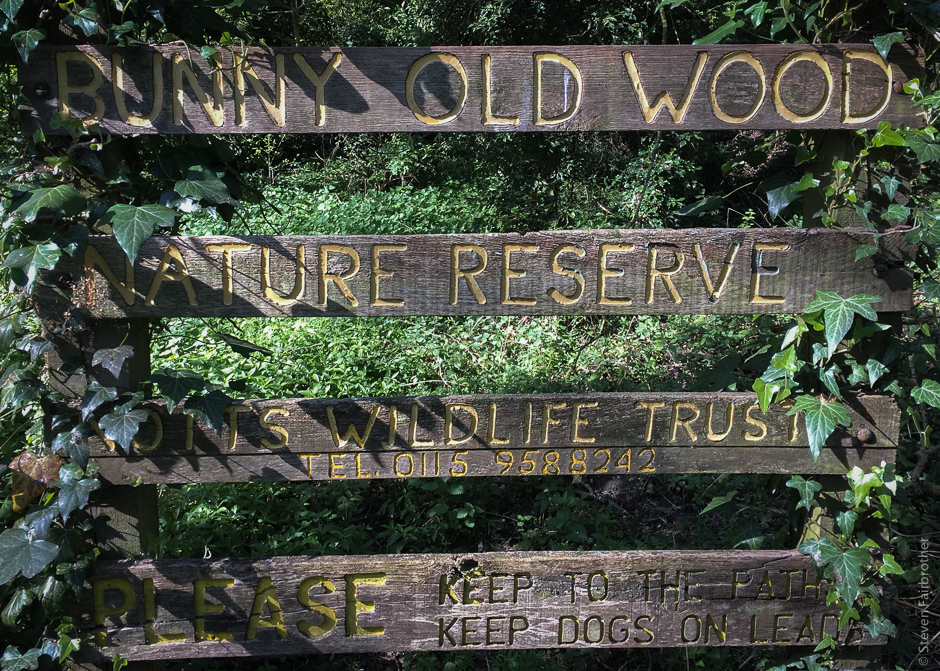Bluebells are one of spring’s treats, flowering early before the trees come into leaf and block out the light.
The UK has over half of the world’s bluebell population, so I thought it was about time I had a go at photographing them.
Bunny Old Wood – Nottinghamshire

Featured in my recent Nottinghamshire Wildlife Trust’s newsletter, this ancient woodland is known for it’s bluebells. It’s thought trees may have covered this site for the last 10,000 years, this knowledge definitely adds to the experience when wandering around. The trees are full of birdsong and wrens seemed to accompany me every step of the way. There was no shortage of bluebells, but I couldn’t find a spot for a picture. The most promising of spots was surrounding by a makeshift barrier, I presume they’ve had trouble with people trampling over them. I ended up just having a nice walk and taking a few snaps with my phone, my favourite being the reserves sign of weathered wood and ivy.



Spring Wood – Derbyshire
These bluebells are easily visible as you drive by the woods, which are situated on the banks of Staunton Harold reservoir. This year was the first time I’ve actually parked up and gone in. There were no shortage of blue bells and I actually preferred it to Bunny Old Wood, but there still wasn’t that unbroken carpet of bluebells I was after. So again, I had a good walk around and took some iPhone snaps.

My garden (well, house to be precise)
I’ve a few bluebells in the garden, not quite enough to constitute a carpet, more a welcome mat at best, but it finally dawned on me to use my macro lens and take some detailed shots. As you can see from the setup below, one false move and it would have come crashing down. I tried shooting them as a group before I found the best looking sample I could and shot that by itself, using the group for a nice out of focus background.
I used two remote flashguns, one above the single flower (with a diffuser on) and one bounced off the wardrobe to illuminate the background. I shot tethered, which means my camera was connected to my laptop, this way I could see the results onscreen straight away and make any adjustments. For a number of the shots I held the flash and moved it around for different looks, but for some of the shots where I used focus stacking, the light had to be consistent, so I mounted it on a tripod. Focus stacking is where a number of images are merged, which have all been focused on different areas of the subject, into one image. Macro photography often produces a very shallow depth of field, great for some images but if you want to capture a greater depth of detail, combining images is one way to do it. These images need some retouching, so I’l post them at a later date.

After not having much luck visiting various woods, I finally got lucky with the surprise appearance of a Thick-jawed Orb Weaver spider (I had to look it up). They’re usually found at ground level in the daytime, in amongst leaf litter and often close to water (could be my pond working its magic), they then climb taller vegetation at night. Perhaps me bringing it indoors and dimming the lights gave it the wrong impression as it climbed the bluebell and started to make a web! It definitely added something extra to the shots and I’ve called the one where it’s dangling The Bell Ringer. Clever hey? I was going to tell people it was all intentional, but doubt I’d be believed.

So although I didn’t photograph them in a woodland scene as first hoped, I did really enjoy shooting them with a macro lens. Macro photography is very time consuming, everything is under your control so you can spend hours tweaking the lights and composition, but with a little help from a little spider, I’m pleased with the results.



PS There are true English bluebells and Spanish ones, plus a hybrid of the two. Mine were bought as English but are clearly hybrids. Fiddlesticks. Next year I’ll try the real thing.







One to put on the list for next year is the Clent Hills. A long way out of the local area, but only an hour by motorway. Also Robin wood, North of Melbourne. You don’t get the carpet, but they show up well against the beech trees.
Thanks Tony, I’ll give them a go next year. I went to see Rannerdale Bluebells the other day as I was in that neck of the woods (near Crummock Water, Cumbria), although there aren’t any woods there now. Very impressive place, I took some drone footage which I hope to post soon.